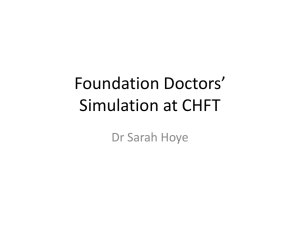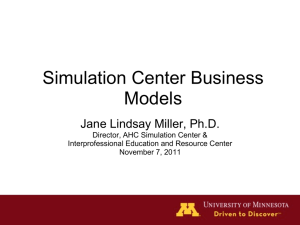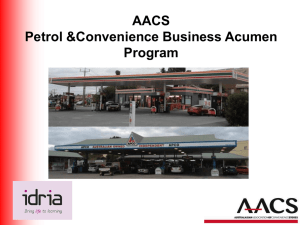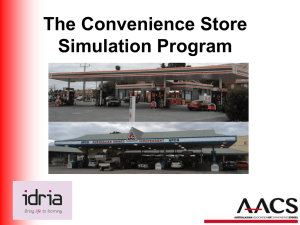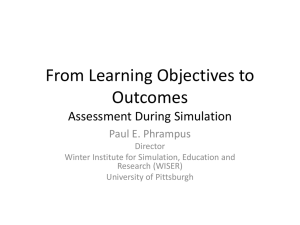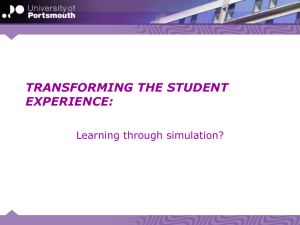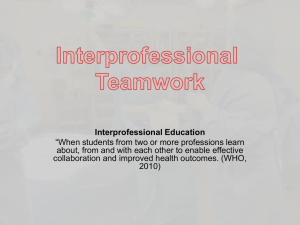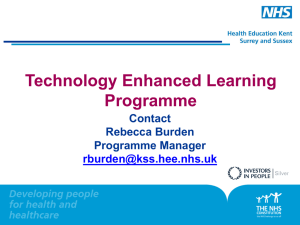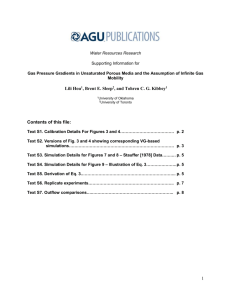Simulations PowerPoint
advertisement
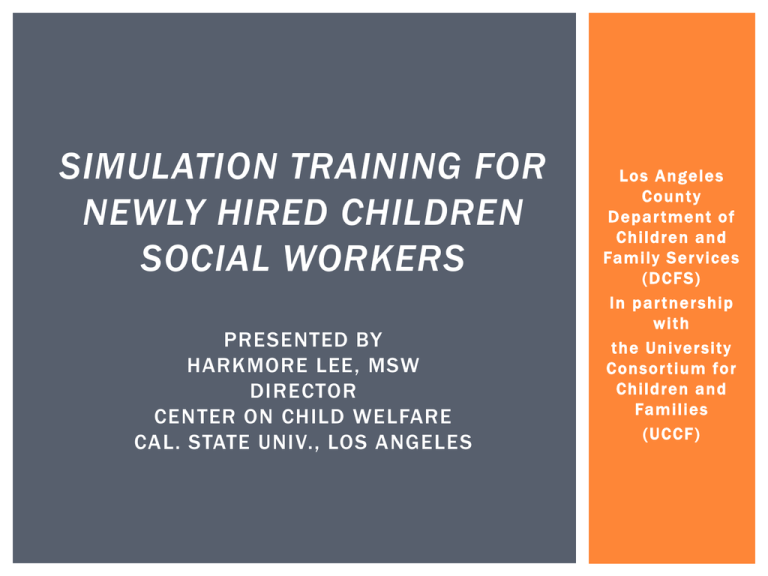
SIMULATION TRAINING FOR NEWLY HIRED CHILDREN SOCIAL WORKERS PRESENTED BY HARKMORE LEE, MSW DIRECTOR CENTER ON CHILD WELFARE CAL. STATE UNIV., LOS ANGELES Los Angeles County Depar tment of Children and Family Ser vices (DCF S) In par tner ship with the Univer sity Consor tium for Children and Families (UCCF) TODAY’S AGENDA I. The “Sim Team” II. Brief History & Defining Simulation III. Key Elements of Simulation Training Program: a) Focus on mission, preparation, and demonstration b) Direction and support from Agency and Schools of Social Work (SSW) Leadership c) Curriculum Design and Development d) Implementation and Logistics e) Research and Evaluation f) Lessons Learned I) INTRODUCING “THE SIM TEAM” Univer sity Consor tium for Children and Families (UCCF ) Cal State, L.A. - Harkmore Lee, MSW Cal State, Long Beach - James Ferreira, MSW UCLA - Heidi Staples, MSW USC - Donna Toulmin, JD Trainers from all 4 UCCF Partners, e.g. Monica McCurdy, Lilli Miles, Alberto Reynoso, Monica Malin, Ana Sufuentes Los Angeles County Depar tment of Children and Family Ser vices (DCF S) – Training Section Beth Minor Michele Brienze Training Section staff, e.g. Edmarine Edwards, Janae Mankowski Los Angeles Of fice of County Counsel Tamera Pruitt Law Enforcement Consultant Warren Ondatje II) BRIEF HISTORY 2013: March – Physical design of “residential simulation lab” developed at Cal State LA . Discuss with DCFS staf f on potential use. July - Aug: Construction of Residential Simulation Lab “mock up” at Cal State LA DCFS and UCCF trainers observe LE simulations Simulation scenarios created; roles defined and rehearsed. Aug. 29th – First simulation for new trainees @ CSULA’s RSL Sept–Dec: Simulations are being fully incorporated into academy trainings Other partners, such as County Counsel, PHNs are brought in. Attention from media CSULB begins to create its own simulation environment II) BRIEF HISTORY 2014: Jan-March LA County Board of Supervisors & Blue Ribbon Commission Reports Cal State LA’s Residential Sim Lab undergoes renovation and upgrade. UCLA begins to create its own simulation environment. April to Present: Cal State LA develops and tests evaluation instruments for simulations. Will design and coordinate evaluation for all sims. USC plans to replicate CSULA’s Residential Sim Lab at their training center. Plans to expand use of simulations to train current CSWs and SCSWs (2,500+ people) over the next two years. WHAT IS SIMULATION? “Simulation is a technique, not a technology, to replace or amplify real experiences with guided experiences, often immersive in nature, that evoke or replicate substantial aspects of the real world in a fully interactive fashion” (Gaba, 2007) “A method of instruction whereby an artificial or hypothetical experience that engages the learner in an activity reflecting real-life conditions but without the risktaking consequences of an actual situation is created.” (Bastable, 2008). SIMULATION IN ACTION @ THE RESIDENTIAL SIM LAB AT CAL STATE LA February 15, 2015 – NBC-4 Los Angeles http://www.nbclosangeles.com/video/#!/on -air/as-seenon/DCFS-Incorporates-Hands-On-Training/245718261 IN GENERAL, SIMULATIONS… …are designed specifically to promote critical thinking, decision making, analysis and problem solving in a safe, controlled and realistic environment. …provide a bridge from theory to practice. …offer trainees the opportunity to prepare and practice their knowledge and skills, while also receiving constructive and supportive feedback from training faculty. …can help increase confidence and competency KEY ELEMENTS OF SIMULATION TRAINING PROGRAM A) FOCUS ON MISSION, PREPARATION, AND DEMONSTRATION CHILD SAFETY, PERMANENCY, WELL-BEING INCREASE T.O.L. OF CRITICAL SKILLS AND COMPETENCIES CORE PRACTICE MODEL B) DIRECTION AND SUPPORT FROM AGENCY & UNIVERSIT Y SSW LEADERSHIP PUSH TO INNOVATE NO MORE “DOING BUSINESS AS USUAL” COLLABORATION, COLLABORATION C) CURRICULUM DESIGN AND DEVELOPEMENT THEORETICAL FRAMEWORKS (KOLB, BANDURA) THEMES, LEARNING OBJECTIVES, FACT PATTERNS SCAFFOLDING AND SEQUENCED LEARNING MULTI-DISCIPLINARY TRAINING TEAMS CRITICAL LEARNING COMPONENTS BASELINE SKILLS AND STANDARDS SAFE LEARNING ENVIRONMENT READINESS PEER LEARNING TRANSFER OF SKILL-BASED LEARNING D) IMPLEMENTATION AND LOGISTICS BUILDING SIMULATION LAB / SETS “ACTORS” = TRAINERS, SUBJECT MATTER EXPERTS FACILITATOR’S GUIDEBOOK FOR EACH SIMULATION PREPPING AND SCHEDULING CONSTRUCTION OF 528 SQ.FT, 1 BED, 1 BA APT. INSIDE A CLASSROOM (CSULA) CONSTRUCTION OF 528 SQ.FT, 1 BED, 1 BA APT. INSIDE A CLASSROOM (CSULA) Residential Sim Lab Construction Costs: a) Initial Mock-up (Aug. 2013; 3 weeks) = $2,000 (materials, staff labor, props donated) b) Lab Renovation & Upgrade (Jan. 2014; 6 weeks) = $18,900 (labor, materials to bring up to building code + creation of storage/prop room. Props donated) c) Installation of AV/Recording/Sounds Effects Equipment for “Closed Set” (Fall 2014) = $ TBD USE OF PARTITIONS IN TRAINING ROOM TO CREATE SIM AREAS (CSULB) USE OF PARTITIONS IN TRAINING ROOM TO CREATE SIM AREAS (UCLA) E) RESEARCH AND EVALUATION HOW DO YOU KNOW IF SIMULATIONS WORK? EXPLORING RESEARCH AND EVALUATION METHODS USED IN OTHER PROFESSIONS WHO USE SIMULATION (E.G. MEDICAL/NURSING, LE, MILITARY) WORK OF MARION BOGO AND MARY RAWLINGS WITH OSCEs (Objective Structured Clinical Examination ) EFFECTIVE EVALUATION METHODS AND RESULTS => SUSTAINABILITY OF SUPPORT F) LESSONS LEARNED FLEXIBLE LEARNING IS POSSIBLE WITHIN A STANDARDIZED FORMAT LESS IS MORE KEEP TRAINERS REFRESHED AFTER NEARLY ONE YEAR, PROGRAM IS BOTH EVOLVING BUT “MATURING” Q&A “TELL ME, AND I WILL FORGET. SHOW ME, AND I MAY REMEMBER. INVOLVE ME, AND I WILL UNDERSTAND.” Confucius, 450 BC BIBLIOGRAPHY B a n d u r a , A . ( 1 977 ) . S e l f - ef fi c ac y : To w a r d a u n i f y i n g t h e o r y o f b e h av i o r a l c h a n g e . P s yc h o l o g i c a l R ev i ew , 8 4 ,1 91 - 21 5 . B a s t a b l e , S . B . ( 2 0 0 8 ) . N u r s e a s e d u c a to r ( 3 e d . ) . S u d b ur y, M a s s a c h us et t s : J o n e s a n d B a r t l et t . B o g o , M . , Re g e h r, C . , K a t z , E . , L o g i e , C . , Tu f fo r d , L . , & L i t va c k , A . ( 2 01 2 ) . E v a l ua t in g a n o b j e c t i ve s t r uc t ur e d c l i ni c a l ex a m i n a t i o n ( O S C E ) a d a p te d f o r s o c i a l w o r k . R e s e a r c h o n S o c i a l Wo r k P r a c t i c e , 2 2 ( 4 ) , 4 2 8 - 4 3 6 . G a b a , D . ( 2 0 07 ) . T h e f u t ur e v i s i o n o f s i m ula t i o n i n h e a l t h c a r e . Q u a l i t y & S a f e t y i n H e a l t h c a r e , 1 3 ( S up p 1 ) , i 2 - i 10 . Ko l b , D . A . ( 1 976 ). T h e L e a r n i n g S t y l e I nve n to r y: Te c h n i c a l M a n u a l , B o s to n , M a . : M c B e r. Ko l b D . A . ( 1 9 8 4 ). E x p e r i e n t i a l L e a r n i n g ex p e r i e n c e a s a s o u r c e o f l e a r n i n g a n d d eve l o p m e n t , N ew J e r s ey : P r e n t i c e H a l l . To ku m a t s u , G o r d o n ( r e p o r te r ) . ( 2 01 4 , Fe b r u a r y 1 5 ) . " D C FS I n c o r p o r a te s H a n d s - o n Tr a i ni n g . " 6 : 3 0 N ew s ( te l ev i s i o n n ew s c a s t ) . L o s A n g e l es , C A : K N B C - C h a n n e l 4 . Ret r i eve d f r o m h t t p : / / w w w.n b c l o s a n g e l e s . c o m/ o n - ai r / a s - s e e n - o n / D C F S - I nc o r p o r a te s H a n d s - O n -Tr a i ni n g _ L o s - A n g e l e s - 24 571 8 2 61 . h t m l? a k m o b il e = o & n m s = y

